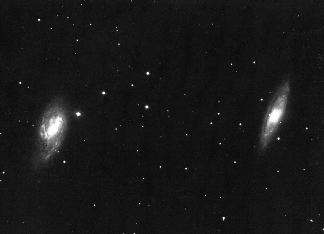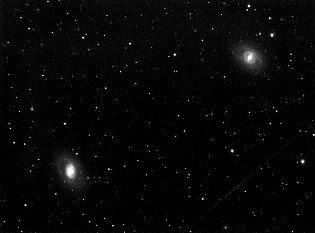Leo
M65/M66 - Pair of Galaxies
M95/M96 - Pair of Galaxies
Leo follows Orion across the sky so as Orion is setting, Leo is highest in the sky. It is seen best in March, April and May. Leo lies away from the obscuring dust of the milky way. This means that it is devoid of any open clusters or star forming regions but, on the other hand, the lack of obscuring dust allows distant galaxies to be seen. Two pairs of Messier galaxies are included in the A-List.
M65 and M66 Spiral Galaxies B L M
A pair of 9th magnitude spiral galaxies visible either together in a low power eyepiece or individually at medium power. M65 is a type Sa spiral (large nucleus, tight spiral arms) that lies at a distance of 35 million light years and has a magnitude of 9.3. M66, considerably larger that M65, is a type Sb spiral (smaller nucleus, more open arms) lying slightly further away at 41 million light years and fractionally brighter at magnitude 8.9. These two galaxies are located halfway between Theta and Iota Leonis and just to the east of the 5th magnitude star 73 Leonis. They can be seen, along with a third galaxy, NGC 3628, just to the north, with a pair of 8x40 or 10x50 binoculars - providing that the sky is very dark and transparent. Sadly in our light polluted skies such conditions do not occur often. The 9th magnitude brightness given for these galaxies seems quite bright, but this is the integrated magnitude over the whole galaxy and each part only shines with the equivalent brightness of a 12th magnitude star. These "faint fuzzies", as they are often called, are quite a challenge!
Positions:
M65 11h 18.9' +13deg 05min
M66 11h 20.1' +12deg 59min
M95 and M96 - Sriral galaxies B L M
This pair of galaxies, separated by just 42 arc minutes, are located close to another Messier galaxy, M105. They lie between the 5th magnitude stars 52 and 53 Leonis and are almost due east of Regulus. A good way to find them with an equatorially mounted telescope is to put Regulus towards the southern side of the finderscope or low power telescope field of view, lock the declination axis and move just under 9 degrees east. This should bring you to M95; with M96 a further 42 arc minutes east of M95. M95 is a barred spiral of Hubble type SBb lying at a distance of 38 million miles with an integrated visual magnitude of 9.7. Under ideal conditions it looks a little like Saturn; a central concentration of light - the nucleus - looking like the planet and the bar looking like the rings. This is visible with a 4 inch (100mm) telescope but a larger aperture will certainly help! M96 is slightly further away, at 41 million miles, and is a type Sa galaxy with a magnitude of 9.2. It has a very condensed central core and can take on the appearance of an eye. These objects are not the easiest to see but, when you do succeed, reflect on the fact that you are looking back in time many millions of years!
Positions:
M95 10h 44.0' +11deg 42min
M96 10h 46.8' +11deg 49min





